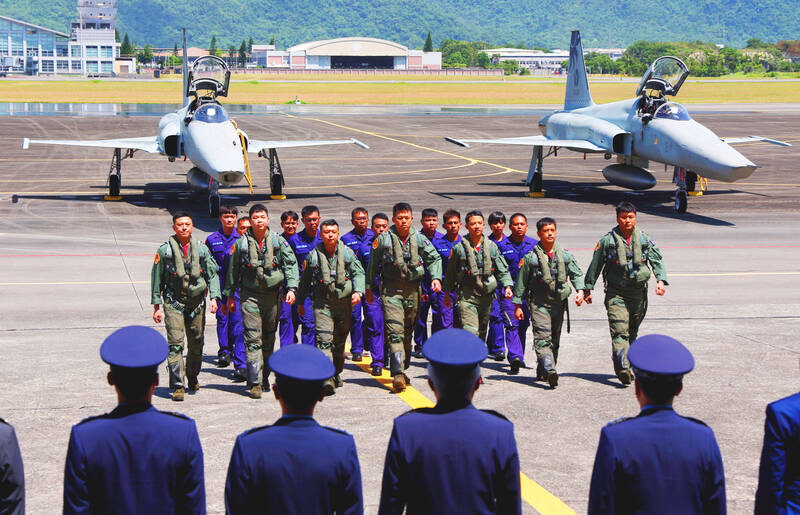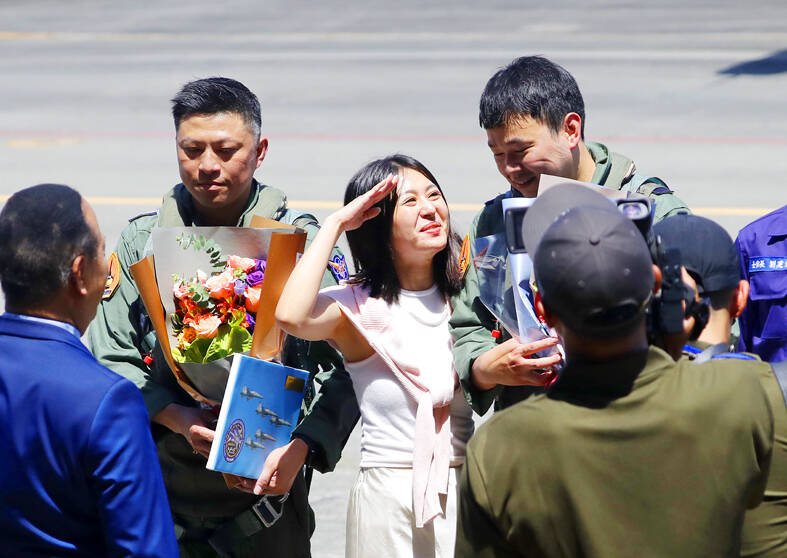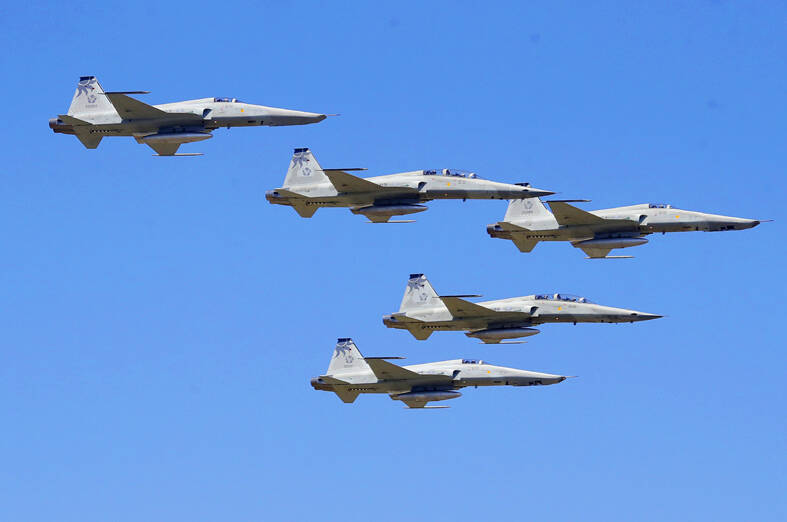A ceremony was held yesterday at Hualien Air Base to mark the official retirement of the air force’s F-5 jets after more than 50 years of patrolling Taiwan’s skies.
The event began with the 5th Tactical Fighter Wing flying a sortie consisting of three RF-5E reconnaissance aircraft and two F-5F jets.
After a brief ceremonial flight around the Hualien base and Taiwan’s east coast, the planes were showered with a water salute upon their return.

Photo: CNA
Air force Colonel Hsu Chun-jung (許俊榮), who was among the pilots that took part in the sortie, reported back to Deputy Minister of National Defense Po Horng-huei (柏鴻輝) saying “mission accomplished.”
In his speech at the ceremony, Po said that the air force was retiring all of the remaining F-5F jets and RF-5E reconnaissance aircraft, which were converted from F-5E jets by Singapore Aerospace Manufacturing in 1997.
The F5-E fighter jets, which were the backbone of the F-5 fleet, were retired in 2023.

Photo: Chiang Ying-ying, AP
“Their retirement today symbolizes an end to the F-5 era,” he said, adding that their missions would be taken over by the RF-16 aircraft.
Speaking to reporters after the sortie, Hsu said that despite it being the plane’s last patrol, the mission was carried out flawlessly.
Although the RF-5Es are now retired, they have preserved many valuable reconnaissance images of Taiwan, he said.

Photo: Chiang Ying-ying, AP
Retired air force colonel Sung Wen-hsi (宋文溪) earlier this week described the Northrop F-5E/F, a variant of the supersonic light fighter known as the Tiger II, as a formidable jet back in the day.
Before the 1995 Taiwan Strait Crisis, the air force was quite powerful and routinely carried out reconnaissance patrols over the airspace of the Kinmen and Matsu, Sung said.
At the time, the air force even demonstrated “a show of power” by flying patrol missions close to China’s coastline, the retired F-5E/F pilot said.
Huang Yang-te (黃揚德), also a retired colonel, said the air force found ways to equip the F-5E/F jets with various capabilities to fulfill combat readiness missions, citing the example that some single-seat F-5Es could even launch Maverick missiles.
The air force began operating F-5A/B jets in 1965.
In 1973, Taiwan partnered with US aircraft manufacturer Northrop Corp to produce the F-5E model domestically under what became known as the Tiger Peace Project.
The first Taiwan-built F-5E rolled out the following year.
Taiwan manufactured a total of 308 jets under the project, including 242 single-seat F-5Es and 66 twin-seat F-5Fs.
The F-5 served as the nation’s main combat aircraft from the 1970s through the 1990s before being reassigned for training purposes.
The F-5E/F jets have ended their training role as the air force is receiving Brave Eagle jet trainers developed under the indigenous aircraft program.

Taiwan is to commence mass production of the Tien Kung (天弓, “Sky Bow”) III, IV and V missiles by the second quarter of this year if the legislature approves the government’s NT$1.25 trillion (US$39.78 billion) special defense budget, an official said yesterday. Commenting on condition of anonymity, a defense official with knowledge of the matter said that the advanced systems are expected to provide crucial capabilities against ballistic and cruise missiles for the proposed “T-Dome,” an advanced, multi-layered air defense network. The Tien Kung III is an air defense missile with a maximum interception altitude of 35km. The Tien Kung IV and V

The disruption of 941 flights in and out of Taiwan due to China’s large-scale military exercises was no accident, but rather the result of a “quasi-blockade” used to simulate creating the air and sea routes needed for an amphibious landing, a military expert said. The disruptions occurred on Tuesday and lasted about 10 hours as China conducted live-fire drills in the Taiwan Strait. The Civil Aviation Administration (CAA) said the exercises affected 857 international flights and 84 domestic flights, affecting more than 100,000 travelers. Su Tzu-yun (蘇紫雲), a research fellow at the government-sponsored Institute for National Defense and Security Research, said the air

A strong continental cold air mass is to bring pollutants to Taiwan from tomorrow, the Ministry of Environment said today, as it issued an “orange” air quality alert for most of the country. All of Taiwan except for Hualien and Taitung counties is to be under an “orange” air quality alert tomorrow, indicating air quality that is unhealthy for sensitive groups. In China, areas from Shandong to Shanghai have been enveloped in haze since Saturday, the ministry said in a news release. Yesterday, hourly concentrations of PM2.5 in these areas ranged from 65 to 160 micrograms per cubic meter (mg/m³), and pollutants were

Taiwan’s armed forces have established response protocols for a wide range of sudden contingencies, including the “Wan Chun Plan” to protect the head of state, the Ministry of Defense (MND) said today. After US President Donald Trump on Saturday launched a series of airstrikes in Venezuela and kidnapped Venezuelan President Nicolas Maduro, concerns have been raised as to whether China would launch a similar “decapitation strike” on Taiwan. The armed forces regularly coordinate with relevant agencies and practice drills to ensure preparedness for a wide range of scenarios, Vice Minister of National Defense Hsu Szu-chien (徐斯儉) told reporters before a